AUDI Q5 2015 Owners Manual
Manufacturer: AUDI, Model Year: 2015, Model line: Q5, Model: AUDI Q5 2015Pages: 302, PDF Size: 75.01 MB
Page 151 of 302
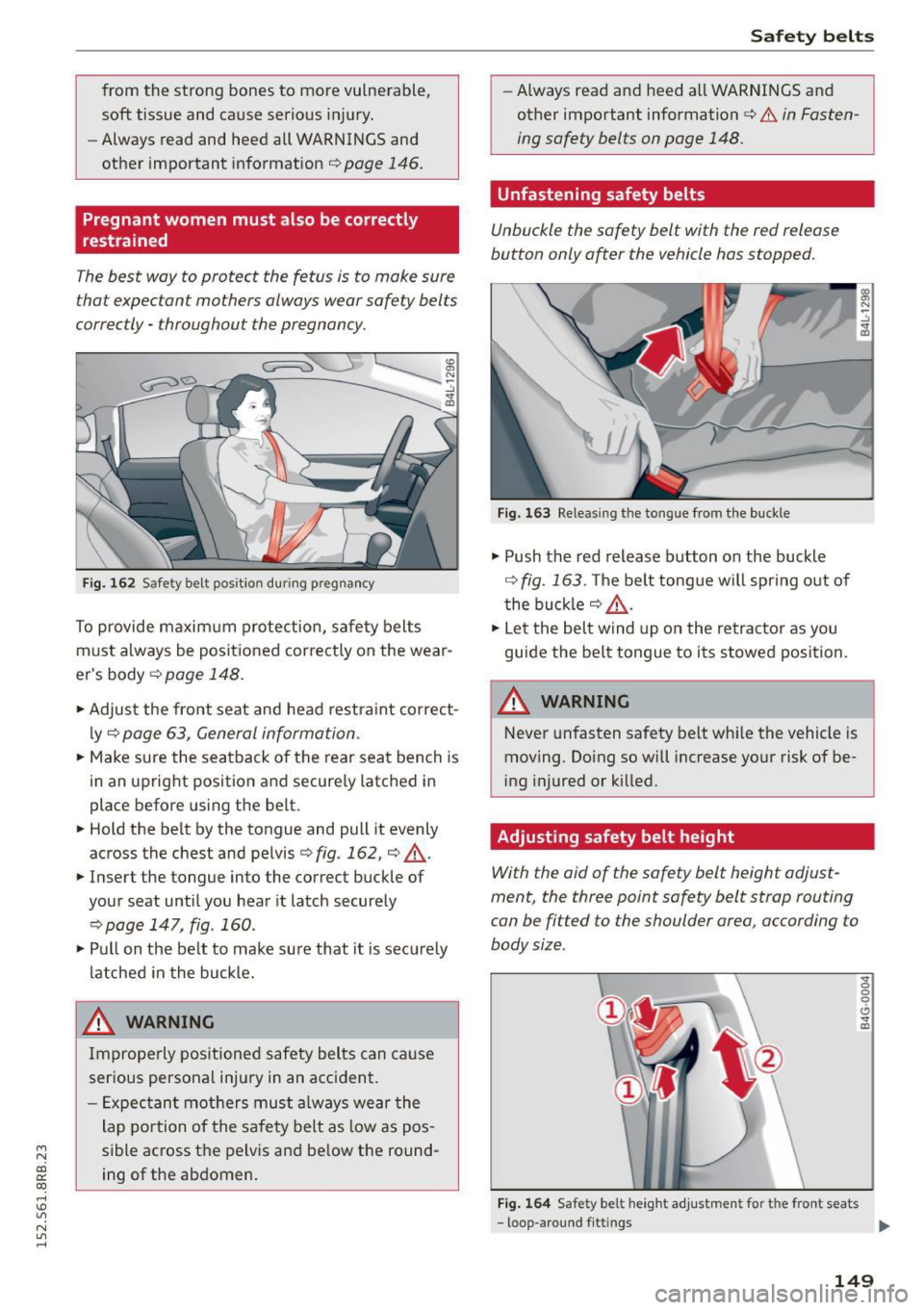
M N
co ~ co
rl I.O
"' N
"' rl
from the strong bones to more vulnerable,
soft tissue and cause serious injury.
- Always read and heed all WARNINGS and
other important information
i::> page 146 .
Pregnant women must also be correctly
restrained
The best way to protect the fetus is to make sure
that expectant mothers always wear safety belts
correctly -throughout the pregnancy .
Fig. 162 Safety belt position during preg nancy
To provide maximum protection, safety belts
must always be positioned correct ly on the wear
er's body
i::> page 148.
• Adjust the front seat and head restraint correct
ly
c:> page 63, General information .
• Make sure the seatback of the rear seat bench is
in an upright position and secure ly latched in
place before using the be lt.
• Hold the belt by the tongue and pull it evenly
across the chest and pelvis
c:> fig . 162, c:> &_ .
• Insert the tongue into the correct buckle of
your seat until you hear it latch securely
i=:>page 147 , fig . 160 .
•Pullon the belt to make sure that it is securely
latched in the buckle.
_& WARNING ,..__
Improperly positioned safety belts can cause
serious personal injury in an accident.
- Expectant mothers must always wear the
lap portion of the safety belt as low as pos
sible across the pelvis and below the round
ing of the abdomen.
Safety belts
-Always read and heed all WARNINGS and
other important information
c:> & in Fasten
ing safety belts on page 148 .
Unfastening safety belts
Unbuckle the safety belt with the red release
button only a~er the vehicle has stopped.
Fig. 163 Releas ing the tongue from the buck le
.,. Push the red release button on the buckle
i=:> fig. 163. The belt tongue will spring out of
the buckle
i::> &_.
• Let the belt wind up on the retractor as you
guide the belt tongue to its stowed position.
_& WARNING
Never unfasten safety belt while the vehicle is
moving . Do ing so will increase your risk of be
i ng injured or killed.
Adjusting safety belt height
With the aid of the safety belt height adjust
ment, the three point safety belt strap routing
can be fitted to the shoulder area, according to
body size .
Fig. 164 Safety belt height adjustmen t fo r the front seats
... 0 0
0
6 ... a,
- loop-around fittings ..,.
149
Page 152 of 302
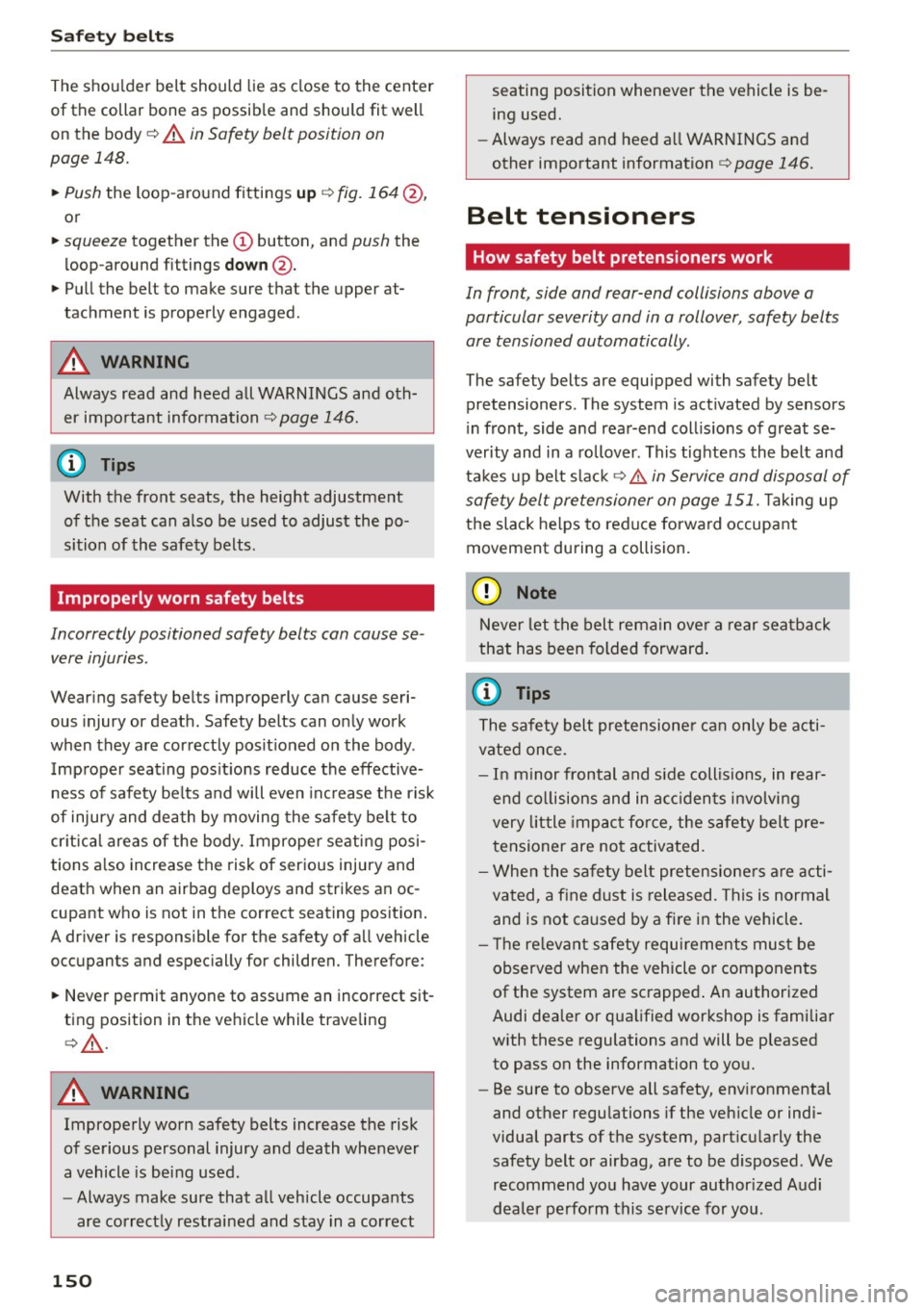
Safe ty belt s
The shou lder belt should lie as close to the center
of the collar bone as possib le and should fit well
on the body
c::> A in Safety belt position on
page 148.
"' Push
the loop -around fittings up c::> fig. 164 @,
or
"'squeeze together the (D button, and push the
loop-around fittings
do wn @.
"'Pull the belt to make sure that the upper at
tachment is properly engaged.
A WARNING
Always read and heed all WARNINGS and oth
er important information
c::> page 146.
(D Tips
With the front seats, the height adjustment of the seat can also be used to adjust the po
sition of the safety belts .
Improperly worn safety belts
Incorrectly positioned safety belts can cause se
vere injuries.
Wearing safety belts improperly can cause seri
ous injury or death. Safety belts can only work
when they are correctly posit ioned on the body .
Improper seating pos it ions reduce the effective
ness of safety be lts and will even increase t he risk
of injury and death by moving the safety be lt to
cr itical areas of the body. Improper seating posi
tions a lso increase the risk of serious injury and
death when an airbag deploys and strikes an oc
cupant who is not in the correct seating posit ion.
A dr iver is responsible for the safety of all vehicle
occupants and espec ially for children. Therefore :
"' Never permit anyone to assume an incorrect sit -
ting position in the vehicle while traveling
c> _& .
A WARNING
Improperly worn safety belts increase the risk
of serious personal injury and death whenever
a vehicle is being used.
- Always make sure that all vehicle occupants
are correctly restrained and stay in a correct
150
seating position whenever the vehicle is being used.
- Always read and heed a ll WARNINGS and
other important information
c> page 146.
Belt tensioners
· How safety belt pretensioners work
In front, side and rear-end collisions above a
particular severity and in a rollover, safety belts
are tensioned automatically.
The safety belts are equipped with safety belt
pretensioners . The system is act ivated by sensors
i n front, side and rear-end coll is ions of great se
verity and in a rollover . This tightens the belt and
takes up belt s lack
c::> .&. in Service and disposal of
safety belt pretensioner on page 151.
T aking up
the slack helps to reduce forward occupant
movement during a collision.
(D Note
Neve r let the belt remain ove r a rear seatback
that has been folded forward .
(D Tips
The safety belt pretensioner can only be acti
vated once.
- In minor frontal and s ide collisions, in rear
end co llisions and in acc idents involving
very little impac t fo rce, the safety belt pre
tensioner are not activated.
- When the safety belt pretensione rs are acti
vated, a f ine dust is released. This is normal
and is not caused by a fi re in the vehicle.
- T he re levant safety requirements mus t be
observed when the vehicle or components
of the system are scrapped . An authorized
Audi dealer or qua lified wor kshop is familia r
with these regulations and will be pleased
to pass on the information to you.
- Be sure to observe all safety, env ironmental
and other regu lations if the veh icle or indi
vidual parts of the system, part icu larly the
safety belt or airbag, are to be disposed. We
recommend yo u have your author ized Audi
dea ler perform this service for you.
Page 153 of 302
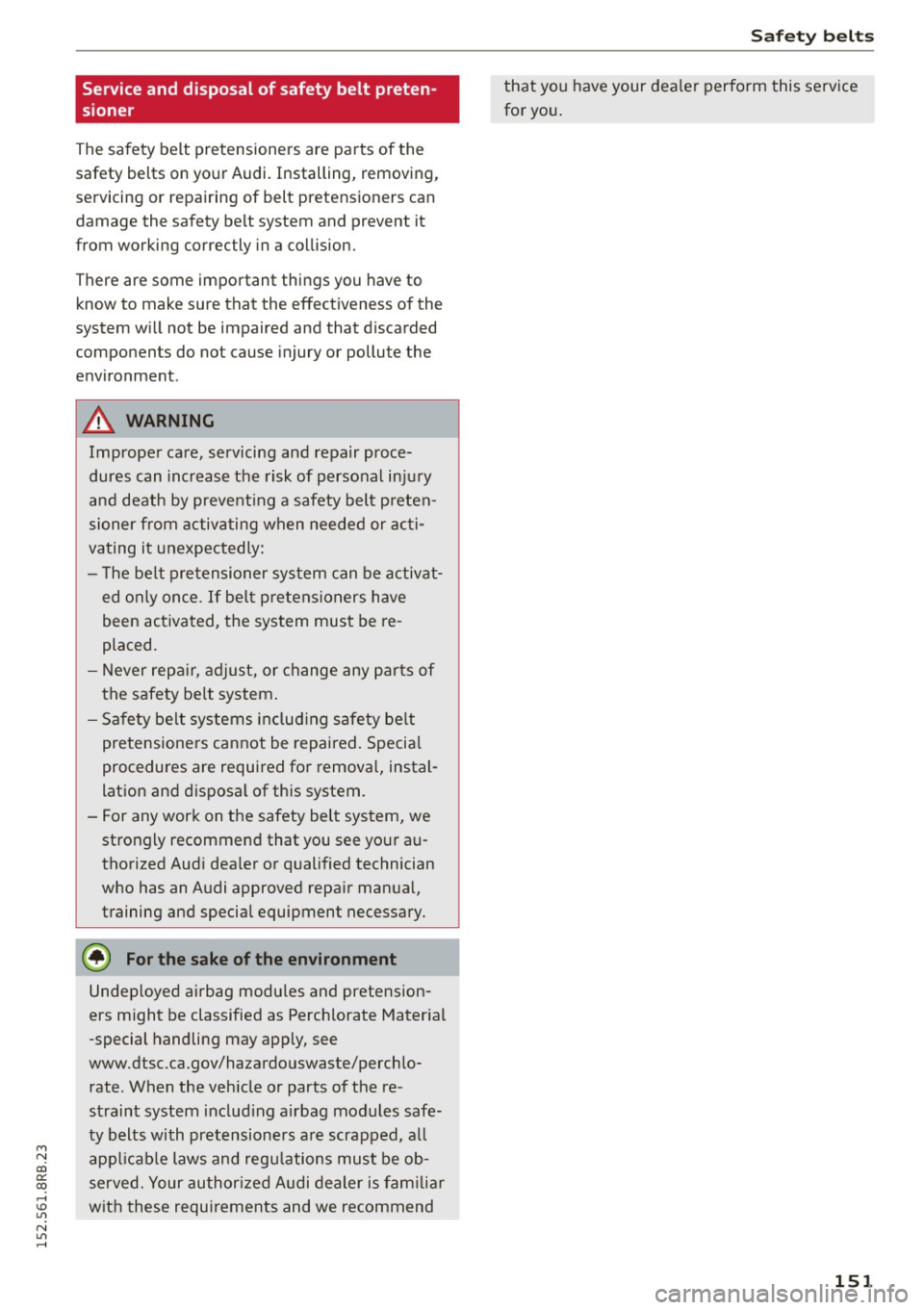
M N
co
a:
co
,...., \!) ..,.,
N ..,., ,....,
Service and disposal of safety belt preten
sioner
The safety belt pretensioners are parts of the
safety belts on your Audi. Installing, removing,
servicing or repairing of belt pretensioners can
damage the safety belt system and prevent it
from working correctly in a collision.
There are some important things you have to
know to make sure that the effectiveness of the
system will not be impaired and that discarded
components do not cause injury or pollute the
environment.
A WARNING
-
Improper care, servicing and repair proce
dures can increase the risk of personal injury
and death by preventing a safety belt preten
sioner from activating when needed or acti
vating it unexpectedly:
- The belt pretensioner system can be activat
ed only once.
If belt pretensioners have
been activated, the system must be re
placed.
- Never repair, adjust, or change any parts of
the safety belt system.
- Safety belt systems including safety belt
pretensioners cannot be repaired. Special
procedures are required for removal, instal
lation and disposal of this system.
- For any work on the safety belt system, we
strongly recommend that you see your au
thorized Audi dealer or qualified technician
who has an Audi approved repair manual,
training and special equipment necessary.
@ For the sake of the environment
Undeployed airbag modules and pretension
ers might be classified as Perchlorate Material
-special handling may apply, see
www.dtsc.ca.gov/hazardouswaste/perchlo rate. When the vehicle or parts of the re
straint system including airbag modules safe
ty belts with pretensioners are scrapped, all
applicable laws and regulations must be ob
served. Your authorized Audi dealer is familiar
with these requirements and we recommend
Safety belts
that you have your dealer perform this service
for you.
151
Page 154 of 302
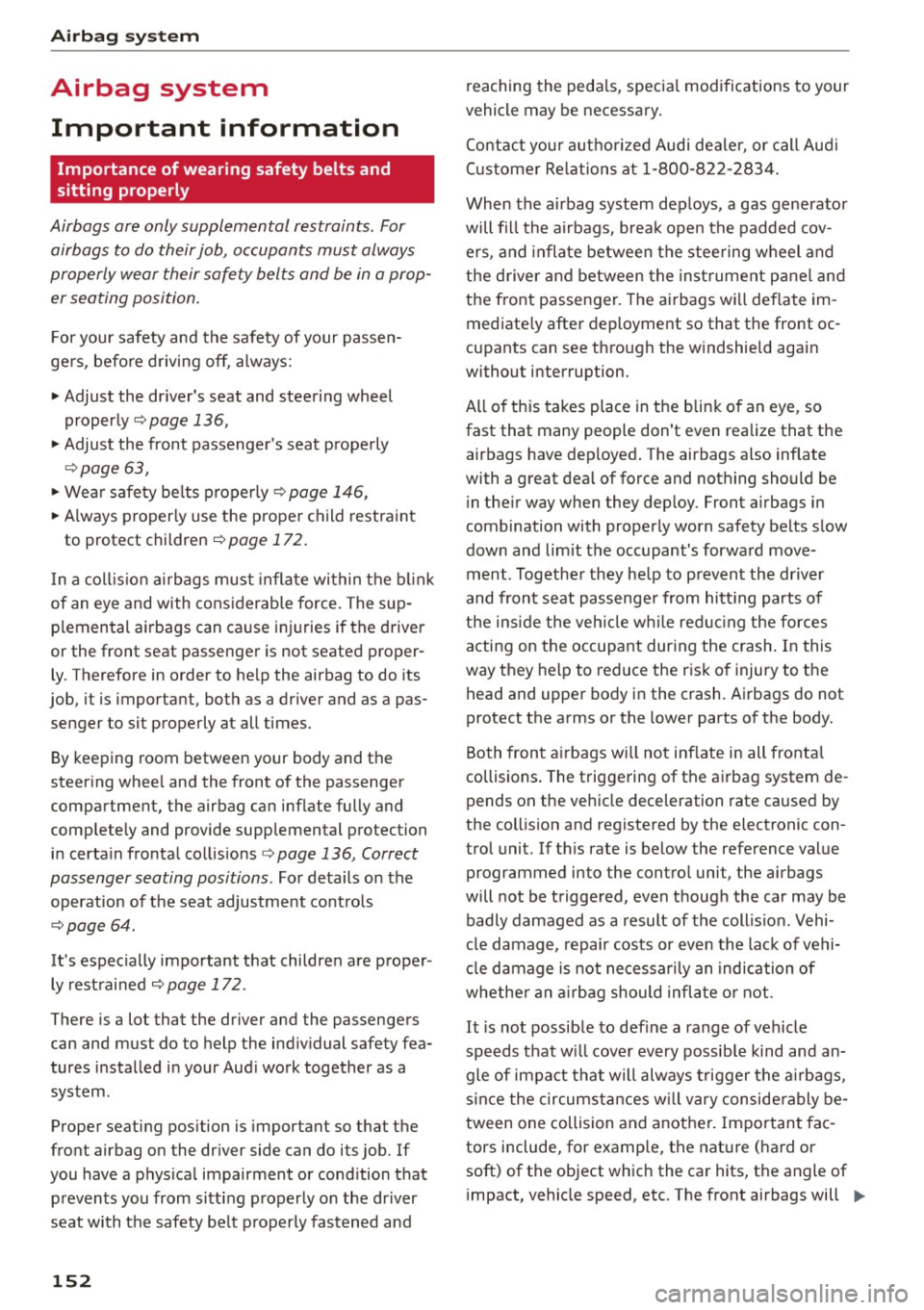
Airbag system
Airbag system
Important information
Importance of wearing safety belts and
sitting properly
Airbags are only supplemental restraints . For
airbags to do their job, occupants must always
properly wear their safety belts and be in a prop er seating position.
For your safety and the safety of your passen
gers, befo re driving off, always:
"' Adjust the driver's seat and steering wheel
properly
Q page 136,
"'Adjust the front passenger's seat properly
Qpage 63,
"'Wear safety be lts properly C? page 146,
"'Always properly use the proper child restraint
to protect children
Qpage 172.
In a coll is ion airbags must inflate within the blink
of an eye and with considerab le force. The sup
p lemental airbags can cause injuries if the driver
or the front seat passenger is not seated proper•
Ly. Therefore in order to help the airbag to do its
job, it is important, both as a driver and as a pas
senger to sit properly at all times.
By keeping room between your body and the
steering whee l and the front of the passenger
compartment, the airbag can inflate fully and
completely and provide supplemental protection
in certain frontal collisions
c> page 136, Correct
passenger seating positions.
Fo r details on the
operation of the seat adjustment controls
c>page 64.
It's especially important that children are proper
ly restrained
Qpage 172.
There is a lot that the driver and the passengers
can and must do to help the individual safety fea
tures installed in your Audi work together as a
system .
Proper seat ing position is important so that the
front airbag on the driver side can do its job. If
you have a phys ical impairment or condition that
prevents you from sitt ing properly on the dr iver
seat with the safety be lt properly fastened and
152
reaching the pedals, specia l modifications to your
vehicle may be necessary.
Contact your authorized Audi deale r, or call Audi
Customer Relat ions at 1-800-822-2834.
When the airbag system dep loys , a gas generator
will fill the airbags, break open the padded cov
ers, and inflate between the steering wheel and
the driver and between the instrument panel and
the front passenger. The airbags wi ll deflate im
mediate ly after deployment so that the front oc
cupants can see through the w indshield again
without interruption.
All o f this takes place in the blink o f an eye, so
fast that many people don't even realize that the
airbags have dep loyed . The airbags also inflate
with a great deal of force and nothing should be
in the ir way when they deploy. Front a irbags in
combination with properly worn safety belts slow
down and lim it the occupant's forwa rd move
ment . Together they he lp to prevent the driver
and front seat passenge r from hitting parts of
the insid e the veh icle wh ile red ucing the forces
acting on the occupant dur ing the crash. In this
way they help to reduce the risk o f injury to the
head and upper body in the crash. Airbags do not
protect the arms or the lower parts of the body.
Both front airbags will not inflate in all fronta l
collisions . The triggering of the airbag system de
pends on the vehicle deceleration rate caused by
the collis ion and registered by the electronic con
trol unit. If this rate is below the reference value
programmed into the control unit, the airbags
will not be triggered, even though the car may be
badly damaged as a result of the coll is ion . Vehi
cle damage, repair costs or even the lack of vehi
cle damage is not necessar ily an indication of
whether an airbag should inflate or not.
It is not possible to define a range of vehicle
speeds that w ill cover every possible kind and an
gle of impact that will always trigger the air bags,
since the circumstances will vary considerably be
tween one collision and another. Impo rtant fac
tors include, for example, the nature (hard or
soft) of the object which the car hits, the angle of
impact, vehicle speed, etc . The front airbags will
IJ>-
Page 155 of 302
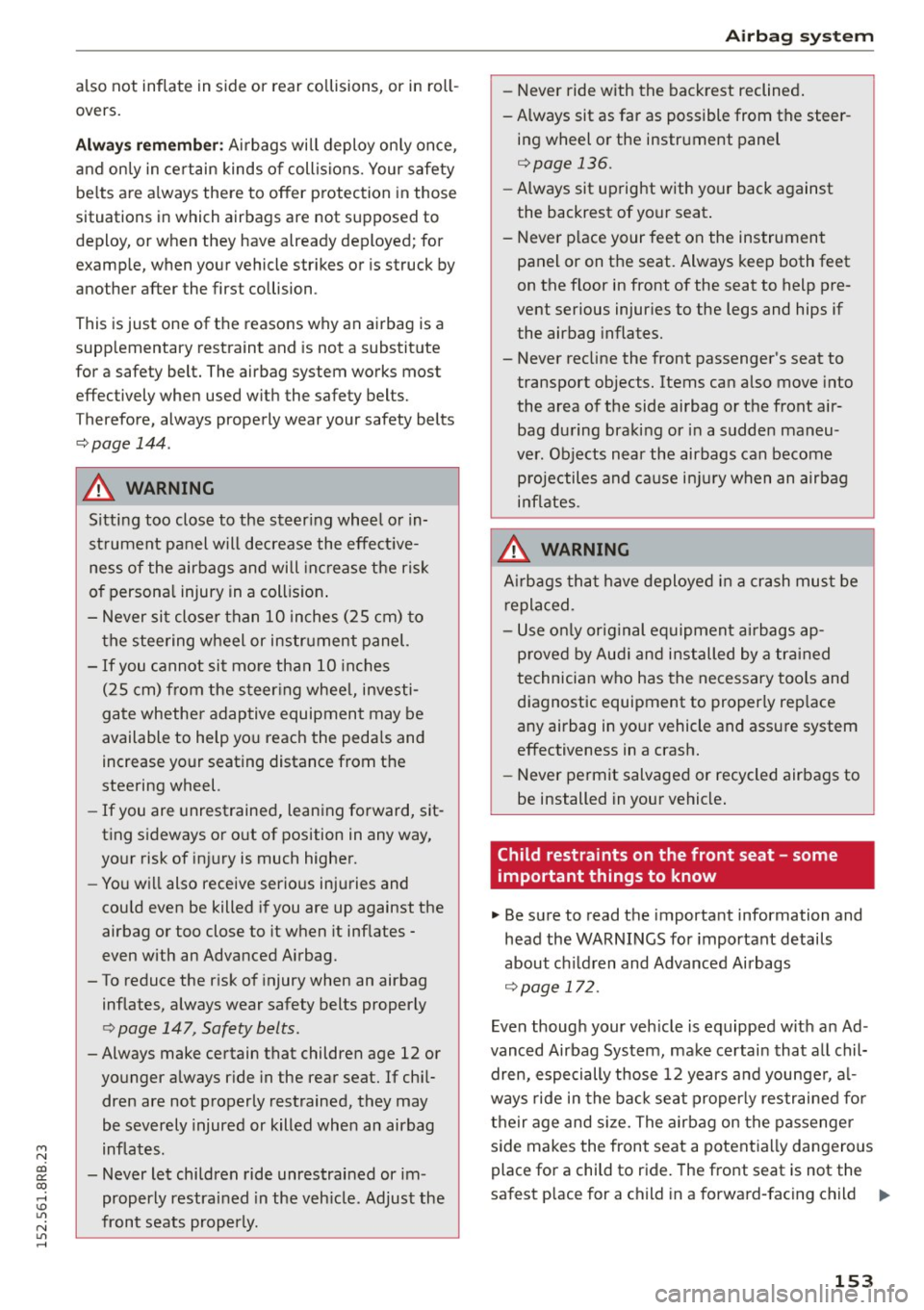
M N
co
a:
co
,...., \!) 1.1'1
N 1.1'1 ,....,
also not inflate in side or rear co llisions, or in roll
overs .
Alwa ys rememb er: Airbag s wi ll deploy on ly once,
and on ly in cer tain kinds of collisions. Your safety
b e lts a re a lways there to offer protection in those
situations in which airbags are not supposed to
deploy, or when they have already deployed; for
examp le, when your vehicle str ikes or is struck by
another after the first collision .
This is just one of the reasons why an airbag is a
supp lementary restraint and is not a substitute
for a safety belt. The airbag system works most
effectively when used w ith the safety belts.
Therefore, always properly wear your safety belts
c::>page 144.
A WARNING
Sitting too close to the steer ing whee l o r in
strument panel will decrease the effect ive
ness of the airbags and will increase the risk
o f persona l injury in a coll is ion .
- Never sit closer than 10 inches (25 cm) to
the steering wheel or instrument panel.
- If you cannot sit more than 10 inches
(25 cm) from the steer ing whee l, investi
gate whethe r adaptive equipment may be
available to help yo u reach the peda ls and
increase your seating distance from the
steering wheel.
- If you are unrestrained, lean ing forward, sit
ting s ideways or out of position in any way,
your risk of in jury is much higher.
- You will also receive serio us injuries and
cou ld even be killed if you are up against the
airbag or too close to it when it inflates -
even with an Advanced Airbag.
- To reduce the r isk of injury when an airbag
inflates, always wear safety belts properly
¢ page 147, Safety belts .
- Always make certain that children age 12 or
younger always r ide in the rear seat. If chil
dren are not properly restrained, they may
be severely injured or killed when an airbag
inflates .
- Never let children ride unrestrained or im
properly restrained in the veh icle. Adjust the
front seats properly.
-
Airbag syste m
- Never ride with the back rest reclined .
- Always sit as far as possible from the steer -
ing wheel o r the instrument panel
c::> page 136.
- Always sit up right with your back against
the backrest of your seat.
- Never p lace your feet on the instrument
panel or on the seat. Always keep both feet
on the floor in front of the seat to help pre
vent serious injur ies to the legs and hips if
the airbag inflates.
- Never recline the front passenger's seat to transport objects. Items can also move into
the area of the side airbag or the front air
bag d uring braking or in a sudden maneu
ver. Objects near the airbags can become
p rojectiles and ca use in jury when an airbag
inflates.
A WARNING
A irbags tha t have deployed i n a crash mus t be
r eplaced.
- Use o nly orig inal equipment airbags ap
p rove d by Aud i an d in stalled by a trained
technici an who has the ne cessary too ls and
diagnostic equipment to properly rep lace
any airbag in yo ur vehicle and assu re system
effectiveness in a crash.
- Never permit salvaged or recycled airbags to
be installed in you r vehicle .
Child restraints on the front seat - some
important things to know
.,. Be su re to read the important information and
head the WARNI NGS for important details
about ch ild ren and Advanced Airbags
c::> page 172.
Even though your veh icle is equipped wit h an Ad
vanced Airbag System, make certain that a ll chil
dren, especially those 12 years a nd you nger, a l
ways ride in the bac k seat properly restrained fo r
the ir age and size. The airbag on the passenger
s ide makes the front seat a potent ia lly dangerous
place for a child to ride. The front seat is not the
sa fest p lace for a child in a forward-facing ch ild ..,.
153
Page 156 of 302
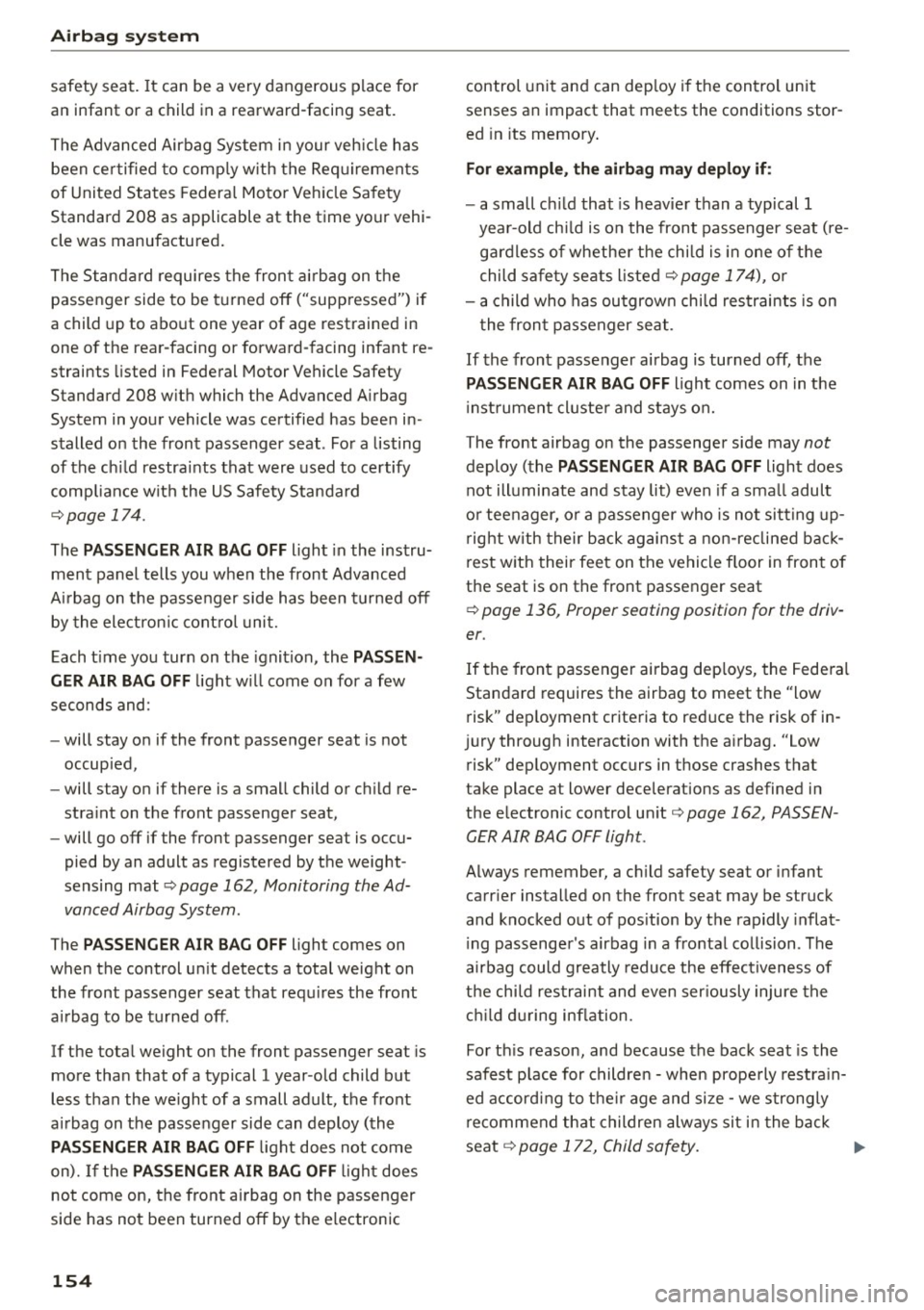
Airbag system
safety seat. It can be a very dangerous place for
an infant or a child in a rearward-facing seat.
The Advanced Airbag System in your veh icle has
been ce rtified to comp ly w ith the Requirements
of United States Federal Motor Vehicle Safety
Standard 208 as applicable at the time your vehi
cle was manufactured.
The Standard requires the front airbag on the
passenger side to be turned off ("suppressed") if
a child up to about one year of age restrained in
one of the rear-fac ing or forward-facing infant re
straints listed in Federal Motor Vehicle Safety
Standard 208 w ith which the Advanced A irbag
System in your vehicle was certified has been in
stalled on the front passenger seat. Fo r a listing
of the ch ild restraints that were used to certify
comp liance with the US Safety Standard
¢page 174.
The PASSENGER AIR BAG OFF light in the instru
ment panel tells you when the front Advanced
Ai rbag on the passenger side has been turned off
by the electron ic control unit.
E ach t ime you turn on the ignition, the
PASSEN
GER AIR BAG OFF light will come on for a few
seconds and:
- will stay on if the front passenger seat is not
occupied,
- will stay on if there is a small child or child re
stra int on the front passenger seat,
- will go off if the front passenger seat is occu
pied by an adult as registered by the weight
sensing mat¢
page 162, Monitoring the Ad
vanced Airbag System.
The PASSENGER AIR BAG OFF light comes on
when the control un it detects a total weight on
the front passenger seat that requ ires the front
ai rbag to be turned off.
If the tota l weight on the front passenger seat is
more than that of a typical 1 year -old child but
less than the we ight of a small adult, the front
ai rbag on the passenger side can deploy (the
PASSENGER AIR BAG OFF light does not come
on). If the
PASSENGER AIR BAG OFF light does
not come on, the front airbag on the passenger
side has not been turned off by the electronic
154
control unit and can dep loy if the control unit
senses an impact that meets the conditions stor
ed in its memory .
For example, the airbag may deploy if:
-a small ch ild that is heavier than a typical 1
year-old chi ld is on the front passenger seat (re
ga rdl ess of whethe r the child is in one of the
child safe ty seats listed¢
page 174), or
- a child who has outgrow n chi ld restraints is on
the front passenger seat .
If the front passenger airbag is turned off, the
PASSENGER AIR BAG OFF light comes on in the
instr ument cluster and stays on.
The front airbag on the passenger side may
not
deploy (the PASSENGER AIR BAG OFF light does
not illuminate and stay lit) even if a sma ll adult
o r teenager, or a passenger who is not sitt ing up
r ight w ith their back against a non-reclined back
rest with their feet on the vehicle floor in front of
the seat is on the front passenger seat
¢ page 136, Proper seating position for the driv
er .
If the front passenger airbag deploys, the Federal
Standard requires the airbag to meet the "low
risk" deployment criteria to reduce the risk of in
ju ry through interaction with the airbag. "Low
risk" deployment occurs in those crashes that
take place at lower decelerations as defined in
the electronic control unit ¢
page 162, PASSEN
GER AIR BAG OFF light .
Always remember, a child safety seat or infant
carr ier installed on the front seat may be struck
and knocked out of position by the rapidly inflat
i ng passenger's airbag in a frontal collision . The
airbag could greatly reduce the effectiveness of
the child restraint and even seriously injure the
child during inflation.
For th is reason, and because the back seat is the
safest place for children - when prope rly restra in
ed accord ing to their age and size -we strong ly
recommend that children always sit in the back
seat ¢
page 172, Child safety. ..,.
Page 157 of 302
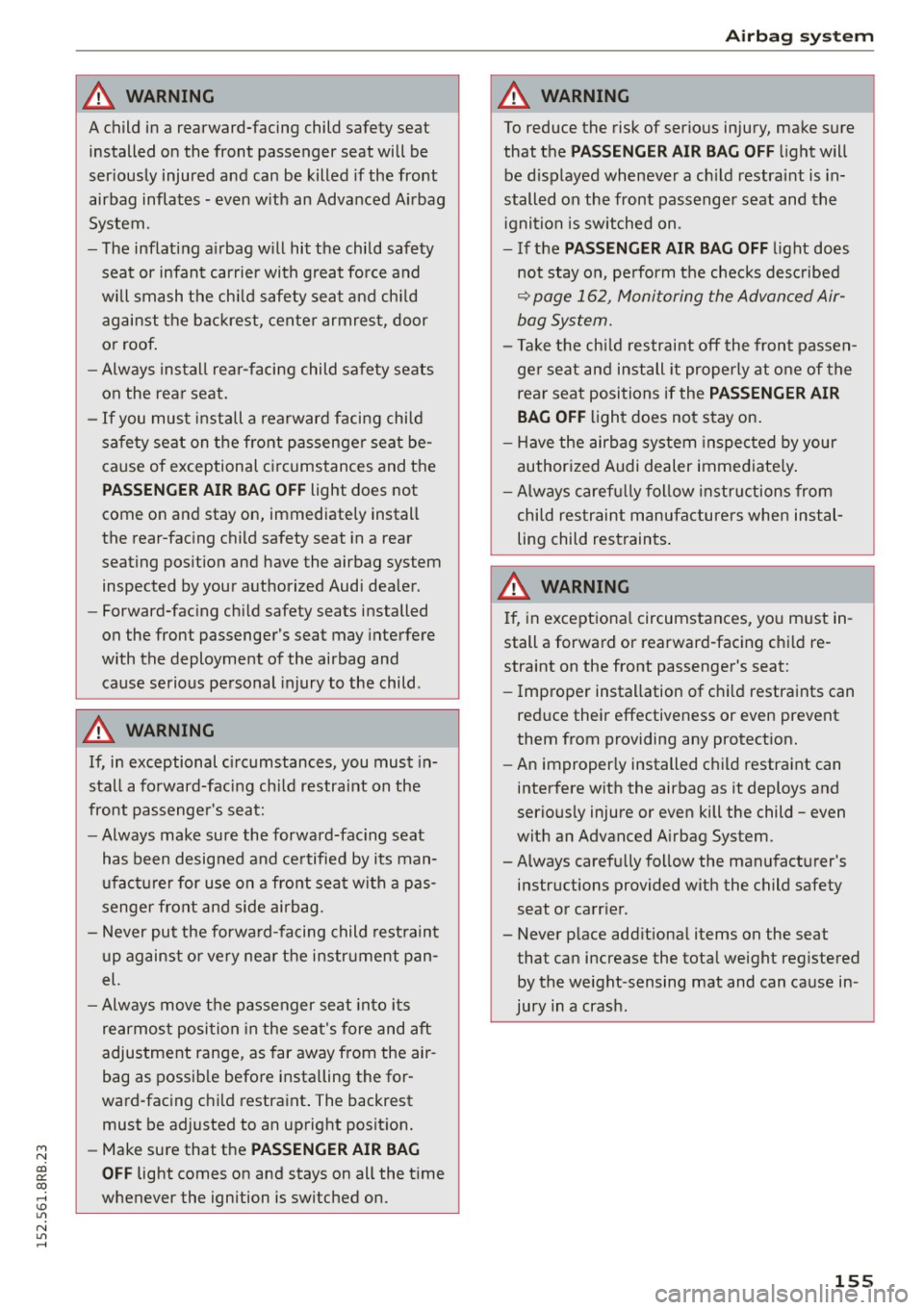
M N
co
a:
co
,...., \!) 1.1'1
N 1.1'1 ,....,
A WARNING ,~
A child in a rearward-facing child safety seat
installed on the front passenger seat will be
seriously injured and can be killed if the front
airbag inflates - even with an Advanced Airbag
System.
- The inflating airbag will hit the child safety
seat or infant carrier with great force and
will smash the child safety seat and child
against the backrest, center armrest, door
or roof.
- Always install rear-facing child safety seats
on the rear seat.
- If you must install a rearward facing child
safety seat on the front passenger seat be
cause of exceptional circumstances and the
PASSENGER AIR BAG OFF light does not
come on and stay on, immediately install
the rear-facing child safety seat in a rear
seating position and have the airbag system inspected by your authorized Audi dealer.
- Forward-facing child safety seats installed
on the front passenger's seat may interfere
with the deployment of the airbag and cause serious personal injury to the child .
A WARNING
If, in exceptional circumstances, you must in
stall a forward-facing child restraint on the
front passenger's seat:
-Always make sure the forward-facing seat
has been designed and certified by its man
ufacturer for use on a front seat with a pas
senger front and side airbag.
- Never put the forward-facing child restraint
up against or very near the instrument pan
el.
- Always move the passenger seat into its
rearmost position in the seat's fore and aft
adjustment range, as far away from the air
bag as possible before installing the for
ward-facing child restraint. The backrest must be adjusted to an upright position.
- Make sure that the
PASSENGER AIR BAG
OFF
light comes on and stays on all the time
whenever the ignition is switched on.
Airbag system
A WARNING
To reduce the risk of serious injury, make sure
that the
PASSENGER AIR BAG OFF light will
be displayed whenever a child restraint is in
stalled on the front passenger seat and the ignition is switched on .
- If the
PASSENGER AIR BAG OFF light does
not stay on, perform the checks described
~ page 162, Monitoring the Advanced Air
bag System.
- Take the child restraint off the front passen
ger seat and install it properly at one of the
rear seat positions if the
PASSENGER AIR
BAG OFF
light does not stay on.
- Have the airbag system inspected by your
authorized Audi dealer immediately.
-Always carefully follow instructions from
child restraint manufacturers when instal
ling child restraints.
A WARNING
If, in exceptional circumstances, you must in
stall a forward or rearward-facing child re
straint on the front passenger's seat:
- Improper installation of child restraints can
reduce their effectiveness or even prevent
them from providing any protection.
- An improperly installed child restraint can
interfere with the airbag as it deploys and
seriously injure or even kill the child -even
with an Advanced Airbag System.
-Always carefully follow the manufacturer's
instructions provided with the child safety
seat or carrier.
- Never place additional items on the seat that can increase the total weight registered by the weight-sensing mat and can cause in
jury in a crash.
155
Page 158 of 302
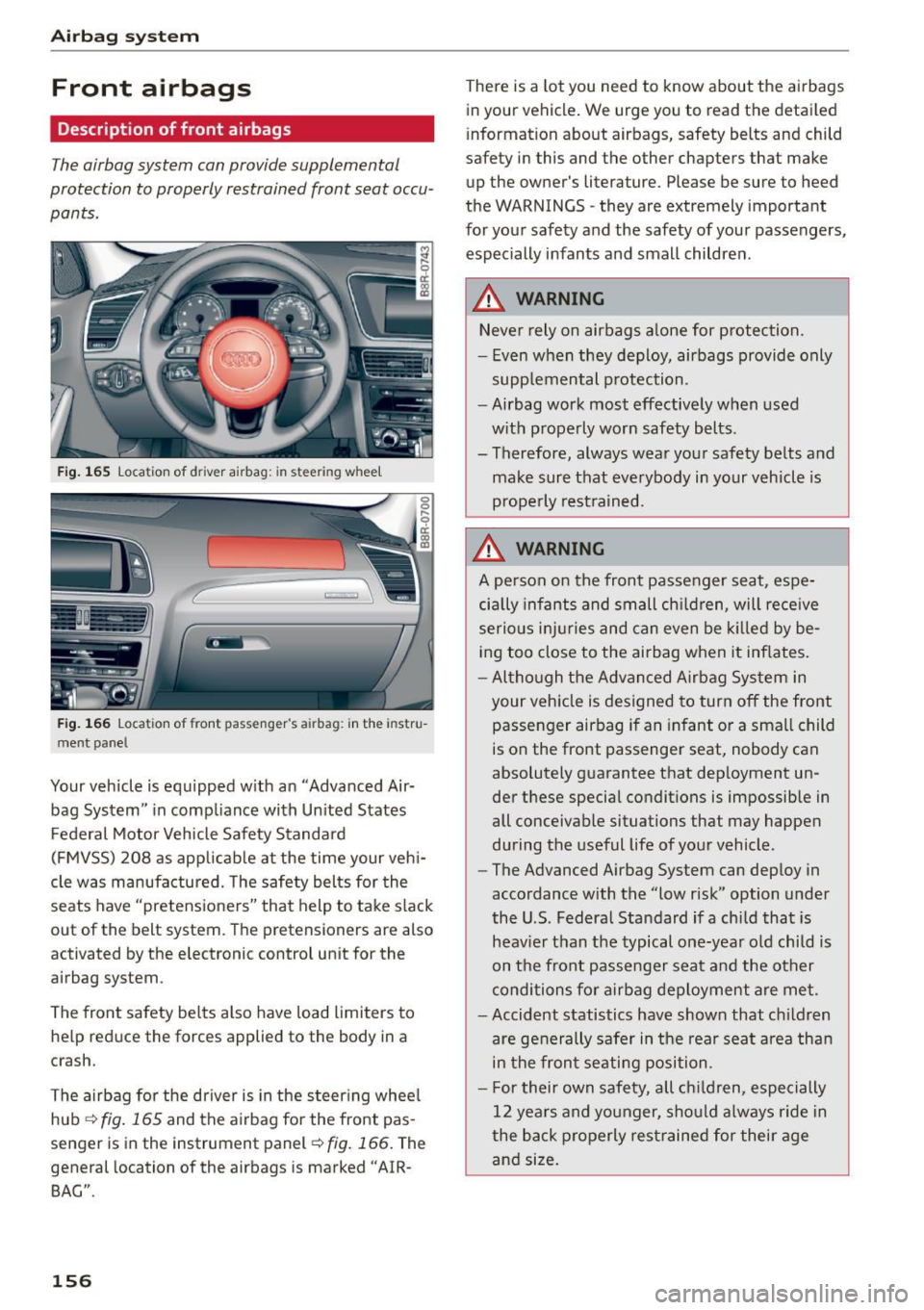
Airb ag syst em
Front airbags
Description of front airbags
The airbag system can provide supplemental
protection to properly restrained front seat occu
pants .
Fig. 165 Location of driver airbag : in steering whee l
Fig. 166 Location of front passenger's airbag: in the instru
ment panel
Your vehicle is equ ipped with an "Advanced Air
bag System" in compliance with Un ited States
Federal Motor Vehicle Safety Standard
(FMVSS) 208 as applicab le at the time your veh i
cle was manufactured. The safety belts for the
seats have "pretensioners" that help to take s lack
out of the belt system . The pretensioners are also
activated by the electronic control unit for the
airbag system .
The front safety belts a lso have load limiters to
help reduce the forces applied to the body in a
crash.
The airbag for the driver is in the steer ing wheel
hub ¢
fig. 165 and the airbag for the front pas
senger is in the instrument panel¢
fig. 166. The
general location of the airbags is marked "AIR
BAG".
156
There is a lot you need to know about the airbags
in your vehicle . We urge you to read the detailed
i nformation about airbags, safety belts and child
safety in this and the other chapters that make
up the owner's literature. Please be sure to heed
the WARNINGS -they are extremely important
for your safety and the safety of your passengers, especially infants and small children .
,&_ WARNING -
Never rely on airbags alone for protection.
- Even when they deploy, airbags provide only supp lemental p rotection.
- Airbag work most effectively when used with properly worn safety belts .
- Therefore, always wear your safety be lts and
make sure that everybody in your vehicle is
prope rly restrained.
,&_ WARNING
A person on the front passenger seat, espe
cially infants and small ch ild ren, will rece ive
serious i njur ies and can even be killed by be
ing too close to the airbag when it inf lates .
- Although the Advanced Airbag System in your vehicle is designed to turn off the front passenger airbag if an infant or a sma ll child
is on the front passenger seat, nobody can
absolutely guarantee that dep loyment un
der these special condit ions is impossible in
all conceivable situations that may happen
during the useful life of your vehicle .
- The Advanced Airbag System can dep loy in
accordance with the "low risk" option under
the U .S. Federal Standard if a chi ld that is
heav ier than the typical one-year old child is
on the front passenger seat and the other
conditions for airbag deployment are met.
- Accident statistics have shown that ch ildren
are generally safer in the rear seat area than
in the front seating position .
- F or their own safety, all ch ildren, especially
12 years and younger, sho uld a lways ride in
the back properly restrained for their age
and size .
-
Page 159 of 302
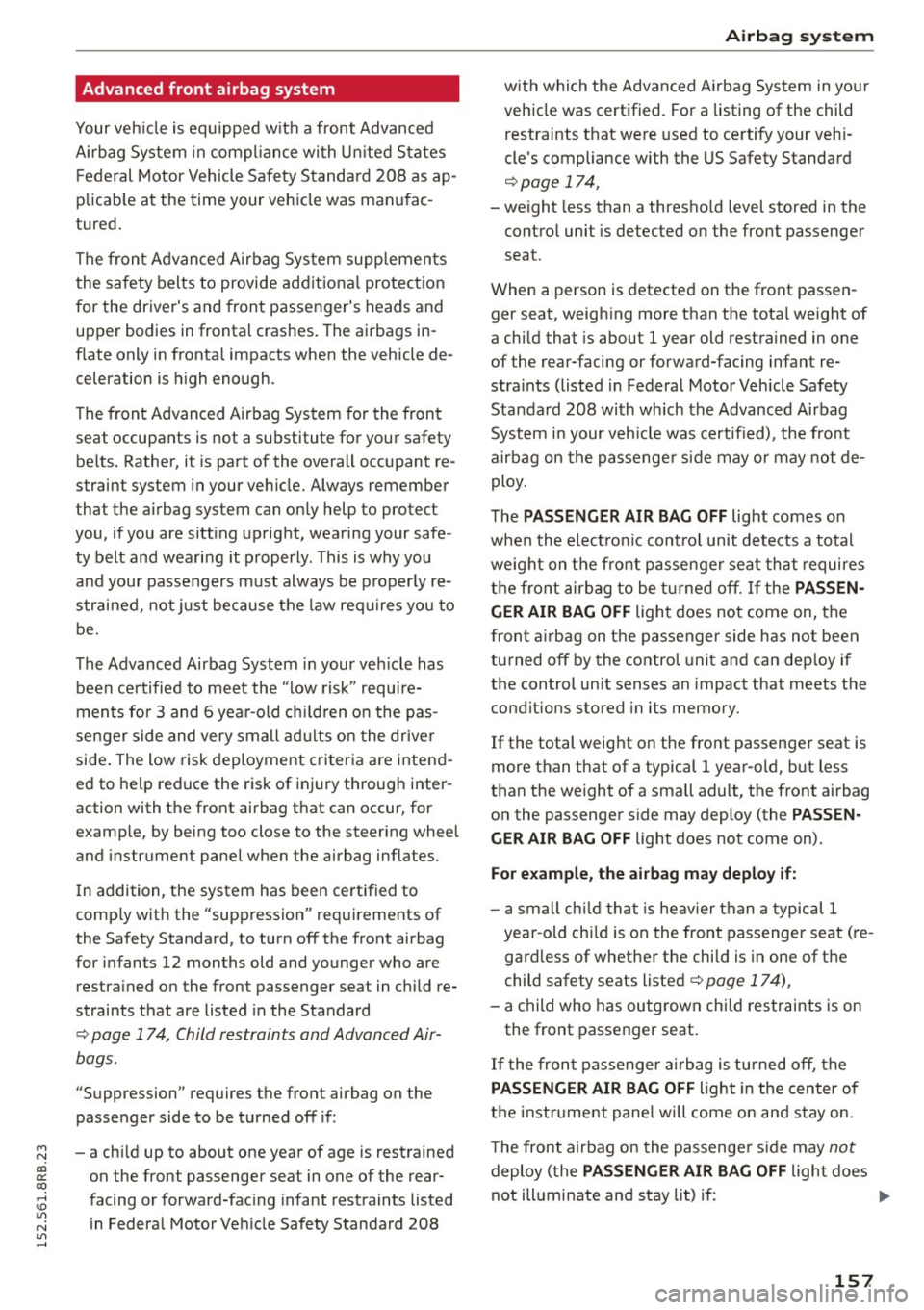
M N
co
a:
co
,...., \!) 1.1'1
N 1.1'1 ,....,
Advanced front airbag system
Your vehicle is equipped w ith a front Advanced
Airbag System in compliance with United States
F ederal Motor Vehicle Safety Standard 208 asap
plicab le at the time your vehicle was manufac
tured.
The front Advanced Airbag System supp lements
the safety belts to provide additiona l protection
for the driver's and front passenger's heads and
upper bodies in frontal crashes. The airbags in
flate only in frontal impacts when the vehicle de
celeration is high enough.
The front Advanced Airbag System for the front
seat occupants is not a substitute for your safety
be lts. Rather, it is part of the overall occupant re
straint system in your vehicle. Always remember
that the airbag system can only help to protect
you, if you are sitt ing upright, wearing your safe
ty belt and wearing it properly . This is why you
and your passengers must always be properly re
strained, not just because the law requires you to
be.
The Advanced Airbag System in your veh icle has
been certified to meet the "low risk" require
ments for 3 and 6 year-old children on the pas
senger side and very small adults on the driver
side . The low risk deployment criter ia are intend
ed to help reduce the risk of injury through inter
action with the front airbag that can occur, for
examp le, by being too close to the steering whee l
and instrument panel when the airbag inflates.
I n addition, the system has been certified to
comp ly with the "suppression" requirements of
the Safety Standard, to turn
off the front airbag
for infants 12 months old and younger who are
restra ined on the front passenger seat in child re
straints that are listed in the Standard
c::> page 174, Child restraints and Advanced Air
bags.
"Suppression" requires the front airbag on the passenger side to be turned
off if:
- a ch ild up to about one year of age is restrained
on the front passenger seat in one of the rear
facing or forward-fac ing infant restraints listed
in Federa l Motor Veh icle Safety Standard 208
Airbag system
with which the Advanced Airbag System in your
vehicle was certified. For a listing of the child
restraints that were used to certify your veh i
cle's compliance with the US Safety Standard
c::>page 174,
- weight less than a thresho ld level stored in the
control unit is detected on the front passenger
seat.
When a person is detected on the front passen
ger seat, weighing more than the tota l weight of
a child that is about 1 year old restrained in one
of the rear-facing or forward-facing infant re
stra ints (listed in Federal Motor Vehicle Safety
Standard 208 with which the Advanced Airbag
System in your veh icle was certified), the front
airbag on the passenge r side may or may not de
ploy.
The
PASSENGER AIR BAG OFF light comes on
whe n the electronic contro l unit detects a total
weight on the front passenger seat that requires
the front airbag to be turned
off. If the PASSEN
GER AIR BAG OFF
light does not come on, the
front airbag on the passenger side has not been
turned
off by the control unit and can deploy if
the control un it senses an impact that meets the
condit ions stored in its memory.
If the total weight on the front passenger seat is
more than that of a typical 1 year-old, but less
than the weight of a small adult, the front airbag on the passenger s ide may deploy (the
PASSEN
GER AIR BAG OFF
light does not come on).
For example , the airbag may deploy if:
- a small child that is heav ier than a typical 1
yea r-old chi ld is on the front passenger seat (re
gardless of whether the chi ld is in one of the
child safety seats listed
c::> page 174),
- a child who has outgrown child restraints is on
the front passenger seat.
If the front passenger airbag is turned off, the
PASSENGER AIR BAG OFF light in the center of
the instrument panel wi ll come on and stay on.
T he front airbag on the passenge r sid e may
not
deploy (the PASSENGER AIR BAG OFF light does
not illuminate and stay lit) if: .,..
157
Page 160 of 302
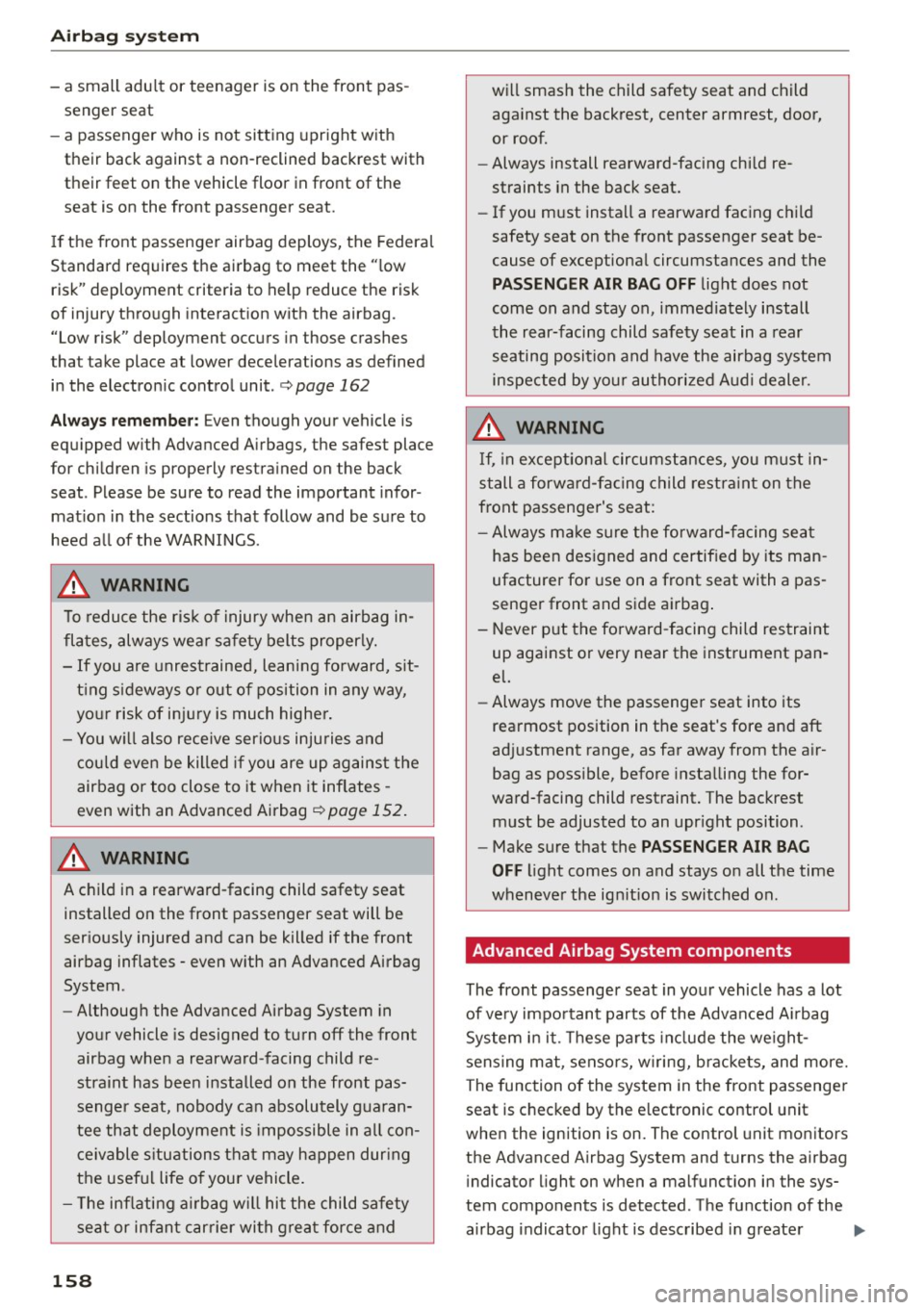
Airbag syste m
-a small adu lt or teenager is on the front pas
senger seat
- a passenger who is not sitting upright with
their back against a non -reclined backrest with
their feet on the vehicle floor in front of the
seat is on the front passenger seat.
I f the front passenger airbag deploys, the Federal
Standard req uires the airbag to meet the " low
risk" deployment criteria to help reduce the risk
of injury through interaction with the airbag .
"Low risk" deployment occurs in those crashes
that take place at lower decelerations as defined in the electron ic control unit . ¢ page
162
Alw ays re member: Even though your vehicle is
equ ipped w ith Advanced Airbags, the safest place
for children is properly restrained on the back
seat . Please be sure to read the important infor
mat ion in the sections that follow and be sure to
heed a ll of the WARNINGS.
_& WARNING
To reduce the ris k of injury when an airbag in
fla tes, always wear safety belts proper ly.
- If you are unrestrained, leaning fo rward, s it
t ing s ideways or out of position in any way,
your risk of injury is much higher .
- You w ill also receive serious inju ries and
could even be killed if you are up against the
airbag or too close to it when it inflates -
even with an Advanced Airbag ¢page
152.
_& WARNING
A child in a rearward-facing child safety seat
installed on the front passenger seat will be
ser iously injured and can be killed if the front
airbag inflates - even w ith an Advanced Airbag
System.
- Although the Advanced Airbag System in
your vehicle is designed to turn off the front
airbag when a rearward -facing child re
straint has been installed on the front pas
senger seat, nobody can absolutely guaran
tee that deployment is impossible in al l con
ceivable s ituations that may happen dur ing
the usef ul life o f your vehicle .
- The inflating a irbag w il l hit the child safety
seat or infant carrier wi th great force and
158
w ill smash the child safety seat and child
aga inst the backrest, center armrest, door,
or roof.
- Always install rearward-facing chi ld re
straints in the back seat.
- If you must insta ll a rearward fac ing ch ild
safety seat on the front passenger seat be
cause of exceptional circumstances and the
PAS SENGER AIR BAG OFF light does not
come on and stay on, immediately install
the rear-facing child safety seat in a rear
seating position and have the airbag system
inspected by your au thorized Aud i dealer .
_& WARNING
If, in exceptiona l circumstances, you must in
stall a forwa rd-facing child restra int on the
front passenger's seat:
- Always ma ke sure the forward-facing sea t
has been des igned and certif ied by its man
ufacturer for use on a front seat with a pas
senger front and s ide a irbag .
- Never p ut the fo rward-facing child restraint
up against or very near the instrument pan
el.
-Always move the passenger seat into its
rearmost position in the seat's fore and aft
ad justment range, as far away from the a ir
bag as poss ible, before insta lling the for
ward-facing child restraint. The backrest
must be adjusted to an upr ight position .
- Make sure that the
PASSENGER AIR BAG
OFF
li ght comes on and stays on all the time
whenever the ign it ion is switched on.
Advanced Airbag System components
The front passenger seat in your vehicle has a lot
of ve ry impo rtant parts of the Advanced A irbag
System in it. These pa rts include the we ight
sensing mat, senso rs, w iring, bracke ts, and more.
The function of the system in the front passenge r
seat is checked by the e lectronic control unit
when the ignition is on. The control unit mon itors
the Advanced Airbag System and turns the airbag i ndicator light on when a malfunct io n in the sys
tem components is detected. The function of the
a irbag indicator light is described in greate r